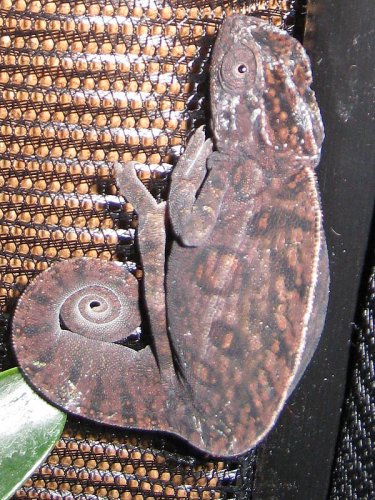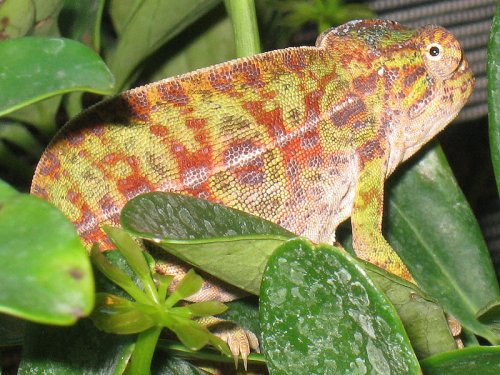Cameron B
Established Member
Hi all,
I bought a pair of Carpets from the Chameleon Company quite recently. They were wild caught's, but were in captivity for over a month and were imported in early January as hatchlings, under 2" total length. I would say they now rate as well established, and it is believed they can be accurately dated age wise at being less than six months, and likely less than five.
Anyways, when they arrived on the 8th (4 days ago), they looked beautiful and quite healthy. I know it's not suggested to put chameleons together, but these two had been before, and since I had a 65 gallon enclosure full of umbrella, lily kim, and hibiscus plants I decided it may be okay. However, the female kept a stressed (black/colorful) coloration and at times made it a point to go after the male, whom continually kept a green, black patterned coloration. I decided that since the female was being so territorial I would go purchase another Reptarium (this time a 38 gallon). I have also put in another Umbrella plant in it for good foilage and put the male into this new enclosure.
Since moving the male into this enclosure he's become very much so more "active" in that he moves around like crazy. He's drinking okay, eats maybe two crickets only a day thus far (he's offered more but just won't eat them), and now has maintained a darker brown/black coloration. I'm not sure what to make of it, but it seems as though it's becoming tough to keep these guys happy! Most of today the female kept going to the bottom of the reptarium and kept the stressed coloration, but just a little while ago she finally turned a greener color with a reddish pattern. I will post some pics in a bit, but need people's opinions.
Is the male stressed? Is it only because he's been moved into the new enclosure last night?
One other thing to mention is that it was a fairly nice day today, and I allowed he and his new enclosure to go outside. During this time there seemed to be a few periods where he was more green that most, but he's back to clinging to the side of the cage and being a very dark color again.
Temperatures:
Basking Spot - 85-90
Ambient - 65-70
Humidity - 55-60%
I mist these guys multiple times daily, and again, they appear to be okay with drinking...eating seems to be on and off. Thanks for any info. The female doesn't seem to eat, even with a cricket cup today.
Cameron
I bought a pair of Carpets from the Chameleon Company quite recently. They were wild caught's, but were in captivity for over a month and were imported in early January as hatchlings, under 2" total length. I would say they now rate as well established, and it is believed they can be accurately dated age wise at being less than six months, and likely less than five.
Anyways, when they arrived on the 8th (4 days ago), they looked beautiful and quite healthy. I know it's not suggested to put chameleons together, but these two had been before, and since I had a 65 gallon enclosure full of umbrella, lily kim, and hibiscus plants I decided it may be okay. However, the female kept a stressed (black/colorful) coloration and at times made it a point to go after the male, whom continually kept a green, black patterned coloration. I decided that since the female was being so territorial I would go purchase another Reptarium (this time a 38 gallon). I have also put in another Umbrella plant in it for good foilage and put the male into this new enclosure.
Since moving the male into this enclosure he's become very much so more "active" in that he moves around like crazy. He's drinking okay, eats maybe two crickets only a day thus far (he's offered more but just won't eat them), and now has maintained a darker brown/black coloration. I'm not sure what to make of it, but it seems as though it's becoming tough to keep these guys happy! Most of today the female kept going to the bottom of the reptarium and kept the stressed coloration, but just a little while ago she finally turned a greener color with a reddish pattern. I will post some pics in a bit, but need people's opinions.
Is the male stressed? Is it only because he's been moved into the new enclosure last night?
One other thing to mention is that it was a fairly nice day today, and I allowed he and his new enclosure to go outside. During this time there seemed to be a few periods where he was more green that most, but he's back to clinging to the side of the cage and being a very dark color again.
Temperatures:
Basking Spot - 85-90
Ambient - 65-70
Humidity - 55-60%
I mist these guys multiple times daily, and again, they appear to be okay with drinking...eating seems to be on and off. Thanks for any info. The female doesn't seem to eat, even with a cricket cup today.
Cameron







